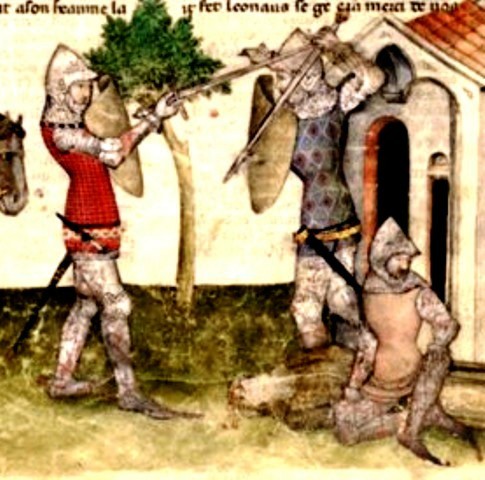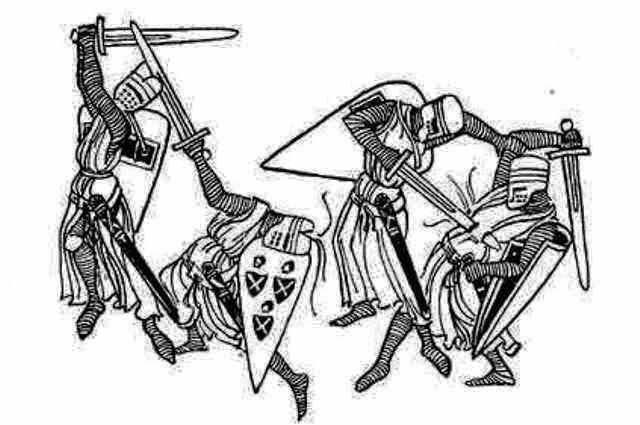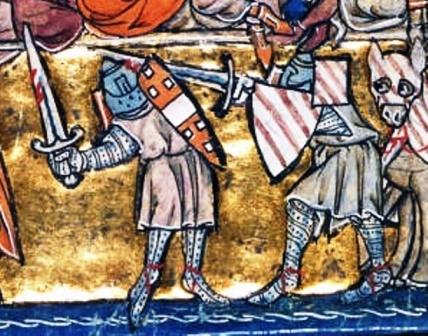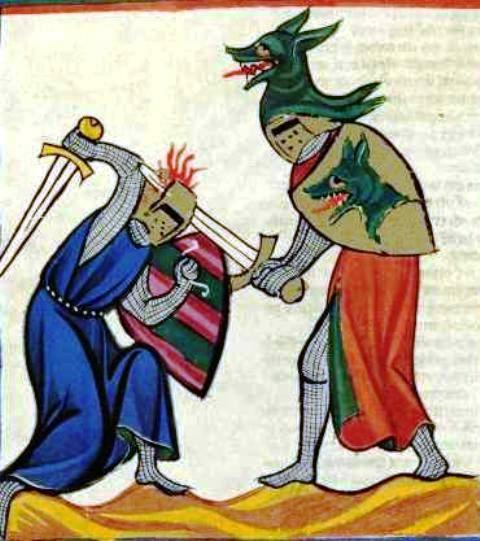| Author |
Message |
|
Timo Nieminen
|
 Posted: Tue 29 Mar, 2011 5:25 pm Post subject: Posted: Tue 29 Mar, 2011 5:25 pm Post subject: |
 |
|
| Michael Curl wrote: | | I wonder if there was also less of a need to be so thoroughly armoured because of a difference in range weapons? I don't know how powerful the avg yumi was but I was under the impression that by the time of the sengoku, crossbows weren't particularly favored. Then again when teppo came in more solid breastplates were introduced. |
I would guess that a typical yumi was about 100lb. Why? First, with the sportification of archery in the 17th century, draw weights in use declined, so the genuine war bows were powerful in comparison to target bows (which might be 40-50lb). Second, the war yumi + war arrow is energy-optimised, giving up any useful capability at long range; generally, this is done for short-range armour penetration, which requires high draw weights.
The first task of Japanese armour was to protect against arrows. The second task, spears. Get reasonable protection against these, and it's worthwhile armour, even if not optimised against swords. Is it worth making the armour more sword resistant? Especially if it isn't grappling + dagger proof, or musket proof.
And then there are Japanese summers to consider, hot and humid.
"In addition to being efficient, all pole arms were quite nice to look at." - Cherney Berg, A hideous history of weapons, Collier 1963.
|
|
   |
 |
Benjamin H. Abbott

|
 Posted: Tue 29 Mar, 2011 8:28 pm Post subject: Posted: Tue 29 Mar, 2011 8:28 pm Post subject: |
 |
|
|
A recent thread on here reveals that some Japanese armor weighed significantly more than 22-44lbs and that the Japanese did at times employ more extensive use of mail bits to protect gaps. I'm curious about what - if any - primary sources exist on the coverage of historical Japanese armor? I know one seventh-century source recommended that gunners in melee combat cut at the helmet or aim for the hands and legs.
|
|
  |
 |
|
Connor Ruebusch
Location: Cincinnati Joined: 10 Nov 2009
Posts: 97
|
 Posted: Tue 29 Mar, 2011 9:15 pm Post subject: Posted: Tue 29 Mar, 2011 9:15 pm Post subject: |
 |
|
| Hugh Knight wrote: | | Connor Ruebusch wrote: | | I don't think Harnischfechten is even specifically a gap-thrusting sort of fighting method, is it? From what I've seen, it usually involves using the halfsworded sword as a lever with which to throw your opponent to the ground, where you could conceivably knife him through the visor or something. Perhaps I'm mistaken. |
With respect, yes, you are mistaken. Certainly there are a great many halfsword techniques that use the sword as a grappling lever, but there are also many thrusting techniques, with both the point and the pommel. In fact, Peter von Danzig tells us that there are four "points" in armored combat: the point of the spear, the point of the dagger and the point and pommel of the sword.
Even with the grappling techniques to which you refer, the text for the grapple usually refers to an opening attack with the point. For example, here is a play from Lignitzer's halfsword material:
"Note: stab him inward to his face. When he displaces this then drive through and attack him outward to his face. If he displaces you again and so strikes your point off, then twist with your pommel around over his right shoulder and spring with your right leg behind his left and throw him back over." (von Danzig fol. 73r) |
I stand humbly corrected.  I really didn't know enough about Harnischfechten to make that assessment in the first place. Thanks for better informing me. I really didn't know enough about Harnischfechten to make that assessment in the first place. Thanks for better informing me.
Ex animo,
Connor
|
|
  |
 |
|
Hugh Knight
|
 Posted: Tue 29 Mar, 2011 9:17 pm Post subject: Posted: Tue 29 Mar, 2011 9:17 pm Post subject: |
 |
|
| Benjamin H. Abbott wrote: | | A recent thread on here reveals that some Japanese armor weighed significantly more than 22-44lbs and that the Japanese did at times employ more extensive use of mail bits to protect gaps. I'm curious about what - if any - primary sources exist on the coverage of historical Japanese armor? I know one seventh-century source recommended that gunners in melee combat cut at the helmet or aim for the hands and legs. |
Some did, some didn't. The very heavy suit pictured on that thread was almost solid plate--they didn't date it on the thread, but my guess is that it was very late, because most solid steel do are. The quote from Otake-shihan may refer to older armors because Katori Shinto-ryu was founded relatively early--it's the oldest extant ryu out there (with the possible exception of Maniwa Nen). Alternatively, the very heavy suits could be either overly heavy modern reproductions or authentic pieces that are unusually heavy (like the Avant harness). Regardless, I'm pretty sure he'd have a good sense of average weight because he is a professional appraiser of andtique armor and weapons.
Regards,
Hugh
www.schlachtschule.org
|
|
    |
 |
|
Hugh Knight
|
 Posted: Tue 29 Mar, 2011 9:18 pm Post subject: Posted: Tue 29 Mar, 2011 9:18 pm Post subject: |
 |
|
| Connor Ruebusch wrote: | I stand humbly corrected.  I really didn't know enough about Harnischfechten to make that assessment in the first place. Thanks for better informing me. I really didn't know enough about Harnischfechten to make that assessment in the first place. Thanks for better informing me. |
Don't feel bad, I know of several people who preach the same thing you were saying who ought to know better, so it's the kind of thing that gets repeated around a lot.
Regards,
Hugh
www.schlachtschule.org
|
|
    |
 |
|
Hugh Knight
|
 Posted: Tue 29 Mar, 2011 9:22 pm Post subject: Posted: Tue 29 Mar, 2011 9:22 pm Post subject: |
 |
|
| Benjamin H. Abbott wrote: | | I know one seventh-century source recommended that gunners in melee combat cut at the helmet or aim for the hands and legs. |
I'm pretty sure you mean "seventeenth century," since that source is referring to firearms, which didn't exist in seventh-century Japan. The helmet cutting reference is odd--it just wouldn't do much good. I wonder if this is a translation problem? Those kinds of things happen all the time. As for the hands and legs, that is perfectly in keeping with the material from Otake-shihan.
Regards,
Hugh
www.schlachtschule.org
|
|
    |
 |
|
Kurt Scholz
|
 Posted: Wed 30 Mar, 2011 1:47 am Post subject: Posted: Wed 30 Mar, 2011 1:47 am Post subject: |
 |
|
| Timo Nieminen wrote: | | And then there are Japanese summers to consider, hot and humid. |
We have not yet looked at a possible relation between armour and climate. Could this be one of the reasons?
|
|
  |
 |
|
Colt Reeves
|
 Posted: Wed 30 Mar, 2011 2:33 am Post subject: Posted: Wed 30 Mar, 2011 2:33 am Post subject: |
 |
|
I believe that has been discussed in other threads. I also think that all of the reasons thus discussed play a part.
"Tears are for the craven, prayers are for the clown.
Halters for the silly neck that cannot keep a crown.
As my loss is grievous, so my hope is small.
For Iron, Cold Iron, must be master of men all..."
-Cold Iron, Rudyard Kipling
|
|
  |
 |
Mick Jarvis

Location: Australia Joined: 18 Jul 2010
Posts: 78
|
 Posted: Wed 30 Mar, 2011 4:00 am Post subject: Posted: Wed 30 Mar, 2011 4:00 am Post subject: |
 |
|
| Hugh Knight wrote: | | The helmet cutting reference is odd--it just wouldn't do much good. I wonder if this is a translation problem? Those kinds of things happen all the time. As for the hands and legs, that is perfectly in keeping with the material from Otake-shihan. |
in the style i do, when we do the armored styles there is cuts to the helmet. but there are some different ones
like cutting to the face, cutting to the eyes/sinus which woudl bing your blade just under the helmet
and the vertical cut straight down on top of the helmet. this one is not to just them in half, but to drive as much force as you can to the blow so you can either stagger them or break their neck
|
|
  |
 |
|
Marcos Cantu
|
 Posted: Wed 30 Mar, 2011 5:32 am Post subject: Posted: Wed 30 Mar, 2011 5:32 am Post subject: |
 |
|
|
are there any video's, tests, etc of weapons effects on the actual armor? the OP was specifically asking about how to defeat the armor itself and not about attacking gaps in coverage...
|
|
  |
 |
Simon G.

|
|
   |
 |
Jean Thibodeau

|
 Posted: Wed 30 Mar, 2011 1:22 pm Post subject: Posted: Wed 30 Mar, 2011 1:22 pm Post subject: |
 |
|
Great test of sword and swordsman but not necessarily what one would do tactically or could do to win a fight:
A) it does take a very much cocked back and very much telegraphed blow leaving one wide open.
B) The top of the helm was successfully split but how deep did the blade go in ? Would the depth of the helm bowl and suspension have kept the swords edge from reaching the skull ?
C) Would the impact and transmitted energy been enough to stun, wound or kill the wearer.
Defeating plate armour tactically also has to stop your opponent before he can do something bad to you and aiming for gaps a better use of the sword but certainly having the skill and a sword capable of cutting armour is better than having one that can't do it or will break or bend in the attempt: It is good to have confidence in the quality of one's weapons.
You can easily give up your freedom. You have to fight hard to get it back!
|
|
  |
 |
Benjamin H. Abbott

|
 Posted: Wed 30 Mar, 2011 2:45 pm Post subject: Posted: Wed 30 Mar, 2011 2:45 pm Post subject: |
 |
|
| Hugh Knight wrote: | | The helmet cutting reference is odd--it just wouldn't do much good. I wonder if this is a translation problem? Those kinds of things happen all the time. |
Maybe. It doesn't make any sense to me either. Sixteenth-century European manuals emphasize thrusting at unarmed parts. Only one ambiguous instruction from Smythe could possibly interpreted as a cut to the helmet with a sword and it wasn't treated as a finishing blow.
|
|
  |
 |
|
Hugh Knight
|
 Posted: Wed 30 Mar, 2011 2:57 pm Post subject: Posted: Wed 30 Mar, 2011 2:57 pm Post subject: |
 |
|
| Benjamin H. Abbott wrote: | | Hugh Knight wrote: | | The helmet cutting reference is odd--it just wouldn't do much good. I wonder if this is a translation problem? Those kinds of things happen all the time. |
Maybe. It doesn't make any sense to me either. Sixteenth-century European manuals emphasize thrusting at unarmed parts. Only one ambiguous instruction from Smythe could possibly interpreted as a cut to the helmet with a sword and it wasn't treated as a finishing blow. |
Oh, that wasn't why I thought it was odd: It's very clear from the iconographic evidence in European artwork that sword blows to the helmet could be expected to incapacitate the wearer; early sources show this all the time. Fechtbuch sources eschew this kind of blow (except with the pommel) because they had developed halfsword techniques by this time, and these were more effective, but blows to the helmet with swords were still practiced in friendly deeds (see the attached picture) even so.
No, the reason I thought this was a translation problem wasn't that it wouldn't have an effect, the reason was because I don't know of any armored techniques in kenjutsu that call for it. I shouldn't have said "it wouldn't do much good" because I was trying to say it wasn't something my sources showed--I just scrambled what I was trying to write (for which I apologize).
Regards,
Hugh
www.schlachtschule.org
|
|
    |
 |
Michael Curl

Location: Northern California, US Joined: 06 Jan 2008
Posts: 487
|
 Posted: Wed 30 Mar, 2011 6:59 pm Post subject: Posted: Wed 30 Mar, 2011 6:59 pm Post subject: |
 |
|
Actually I was trying to find about how to aim at the gaps given that the japanese sword doesn't look to be as thrust or half-sword oriented as their european counterparts.
Another important point to make is that iron was more expensive in japan than in europe.
E Pluribus Unum
|
|
   |
 |
Jean Thibodeau

|
 Posted: Wed 30 Mar, 2011 7:46 pm Post subject: Posted: Wed 30 Mar, 2011 7:46 pm Post subject: |
 |
|
| Benjamin H. Abbott wrote: | | Hugh Knight wrote: | | The helmet cutting reference is odd--it just wouldn't do much good. I wonder if this is a translation problem? Those kinds of things happen all the time. |
Maybe. It doesn't make any sense to me either. Sixteenth-century European manuals emphasize thrusting at unarmed parts. Only one ambiguous instruction from Smythe could possibly interpreted as a cut to the helmet with a sword and it wasn't treated as a finishing blow. |
Don't remember the source but I think these cutting of a quality helmet is traditionally done more in the spirit of testing the skill of the swordsman and the quality of the sword than related to tactical use as I suggested in my earlier post i.e. not related at all to practical fighting techniques.
I imagine that all sorts of things like edge alignment can mean the difference between a cut helm versus a broken or bent sword or just the sword leaving a shallow dent and a successful cutting of a helm is difficult enough that being able to do it is considered a great achievement. 
You can easily give up your freedom. You have to fight hard to get it back!
|
|
  |
 |
Benjamin H. Abbott

|
 Posted: Wed 30 Mar, 2011 10:12 pm Post subject: Posted: Wed 30 Mar, 2011 10:12 pm Post subject: |
 |
|
|
I'm thoroughly skeptical of infantry employing sword blows against helmets, even using a two-handed weapon. While I'm sure you could knock your opponent out with enough time or luck, attacking unarmed parts seems dramatically more effective. The translated wording from that seventeenth-century Japanese could be interpreted as a tacit admission of this dynamic: "If you're awesome you'll cut for the head, but mere mortals do better aiming for the hands and legs."
|
|
  |
 |
|
Timo Nieminen
|
 Posted: Wed 30 Mar, 2011 10:22 pm Post subject: Posted: Wed 30 Mar, 2011 10:22 pm Post subject: |
 |
|
| Michael Curl wrote: | | Another important point to make is that iron was more expensive in japan than in europe. |
Were they? When? By enough to make a difference?
I don't have a good set of European iron prices. In the early 1600s, Japanese iron prices were under 10 English pounds per metric ton (steel prices were higher, by a factor of 5-10 times). Late 1600s English iron prices I've seen mostly vary from just over 10 pounds to 18 pounds per ton, depending on quality. This is AFAIK before the change to mineral fuel (i.e., using charcoal, not coal/coke).
The Japanese iron and steel industry expanded a lot in the 16th century, and Japan exported to Ming China, so they weren't too short of iron and steel.
"In addition to being efficient, all pole arms were quite nice to look at." - Cherney Berg, A hideous history of weapons, Collier 1963.
|
|
   |
 |
|
Hugh Knight
|
 Posted: Wed 30 Mar, 2011 10:23 pm Post subject: Posted: Wed 30 Mar, 2011 10:23 pm Post subject: |
 |
|
| Benjamin H. Abbott wrote: | | I'm thoroughly skeptical of infantry employing sword blows against helmets, even using a two-handed weapon. While I'm sure you could knock your opponent out with enough time or luck, attacking unarmed parts seems dramatically more effective. The translated wording from that seventeenth-century Japanese could be interpreted as a tacit admission of this dynamic: "If you're awesome you'll cut for the head, but mere mortals do better aiming for the hands and legs." |
And I agree with you, believe me. The European iconography, however, supports the practice. My theory is that these represented concussive blows, since obviously one cannot cut armor. When the artist shows bloody cuts in a helmet, he's merely indicating an effective or telling blow, since the crude art of the period was unable to depict the effects more realistically.
 Attachment: 70.75 KB Attachment: 70.75 KB

 Attachment: 32.24 KB Attachment: 32.24 KB

 Attachment: 43.32 KB Attachment: 43.32 KB

 Attachment: 48.07 KB Attachment: 48.07 KB

Regards,
Hugh
www.schlachtschule.org
|
|
    |
 |
|
Sam Gordon Campbell
Location: Australia. Joined: 16 Nov 2008
Posts: 678
|
 Posted: Wed 30 Mar, 2011 11:06 pm Post subject: Posted: Wed 30 Mar, 2011 11:06 pm Post subject: |
 |
|
Hey Hugh, what's the source for the first reference picture you use there (Lancelot99) if you please?
Member of Australia's Stoccata School of Defence since 2008.
Host of Crash Course HEMA.
Founder of The Van Dieman's Land Stage Gladiators.
|
|
  |
 |
|
|

